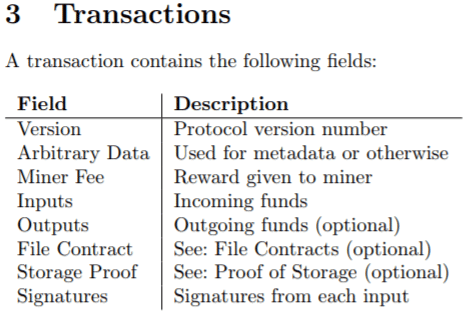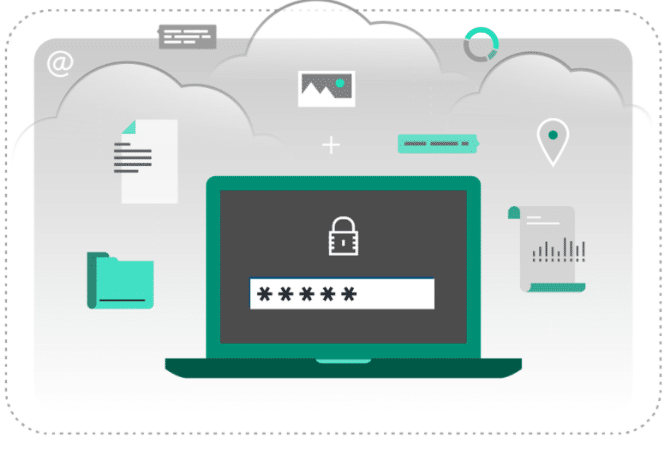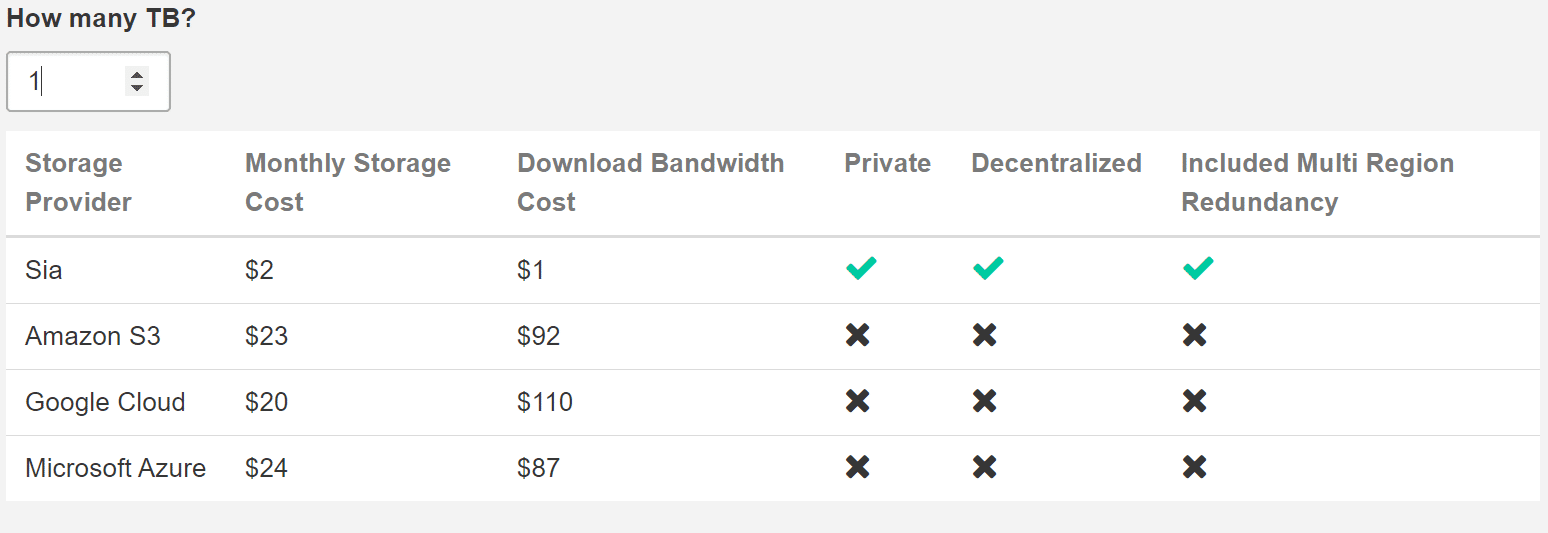Latest news about Bitcoin and all cryptocurrencies. Your daily crypto news habit.
What Is Siacoin?
Siacoin, or Sia for short, provides a decentralized cloud storage option that competes with centralized legacy competitors such as DropBox, Amazon, Apple, and Microsoft. Using Sia, anyone can host or access encrypted storage through the platform, and all contracts, storage proofs, and transactions are verifiable using the blockchain’s public ledger.
Remember that old Apple marketing campaign when the iPhone was in its infancy and the app store craze was in full swing? “There’s an app for that.” Well, blockchain has taken the world for a ride with its own rise in popularity, and as use cases and adoption abound, a similar mantra could ring true: there’s a crypto for that.
Indeed, it seems like development teams are pushing crypto into any existing industry that might have a use case for blockchain. We’ve covered a few of these before, those projects with actual, working services. And, we’ll be covering one of those in more depth with this guide. In this Siacoin guide, we take a look at:
- How Does Siacoin Work?
- Why Sia?
- Siacoin Team and Competitors
- Trading History
- Where to Buy and Store SC
- Siacoin Roadmap
- Final Thoughts
- Additional Siacoin Resources
How Does Siacoin Work?
On a fundamental level, Sia takes cloud storage out of the hands of monolithic providers and puts it back into the hands of individuals. Doing so provides a peer-to-peer storage ecosystem that allows anyone to rent out or take advantage of spare hard drive space.

Sia Transactions
All services on the network receive Siacoin (SC) payments. And all transactions in the Sia ecosystem are secured through filing contracts and storage proofs.
Storage Ecosystem
Sia’s platform consists of both providers (hosts) and clients (users). Through the platform, users commission storage space from hosts, and the hosts are compensated for their services in Siacoin.
The ecosystem provides flexible storage options and is largely free-market driven. Providers can set their own prices, advertise their level of reliability, and set standards for penalties should problems arise in storage (such as lost files). Additionally, they can choose to deny a client storage if they’re uncomfortable with the nature of that client’s data (e.g. sensitive, illegal, or ethically questionable materials).

Sia is a free market ecosystem.
Clients also have a series of protections in place to safeguard their own interests. They have the option to split copies of their data between multiple providers to ensure file security and retrievability. For instance, if a provider were to lose a client’s file or simply refuse to release it, the client could still retrieve their files from another provider’s storage. Both parties can also agree upon contractual penalties that a provider will incur if they don’t provide proof of storage.
Clients have the option to reward providers with uptime incentives on top of the storage fees, as well. With these payments, clients incentivize providers for being more attentive to their needs, which means providing faster document uploads, enhanced upkeep to process requests, etc.
File Contracts
When a client and a provider wish to conduct business, they agree to draft a file contract. While a provider’s hard drive stores all data, Sia’s blockchain stores the contracts for these arrangements.
These file contracts define the terms of a storage agreement and ensure that both parties conduct their business accordingly. Since the contract is stored on the blockchain public ledger, the original arrangement is verifiable and immutable once it has been submitted to the network.
As we went over above, contractual terms are flexible based on circumstance. If a client is willing to sacrifice reliability for affordability, it’s within their right. If a provider wants to charge more for storing mass amounts of data, and the client agrees to the terms of the contract, so be it. Users on the platform must govern their own provider choices based on a host’s reputation and storage requirements. Likewise, a provider must judge whether or not they can accommodate a client based on that client’s needs and demands.

Sia’s blockchain keeps the record of all the network’s file contracts.
Still, file contracts add a much-needed layer of security to the network. They define the duration of an agreement, how often a provider must submit proof of storage, and an agreed-upon payout.
When you create a contract as a client, you upload a balance of Siacoin into the contract for future payments. Thus, whenever you upload a document for storage, some of the money from this balance is transferred to the host. If you don’t use all of your balance and the terms of a contract end, the remaining coins return to your wallet.
Proof of Storage
Sia implements proof of storage to protect clients from fraudulent or malicious providers. In order to receive payment, a provider must present a certain number of proofs to the network within time frames specified by the terms of the file contract.
If a provider fails to provide proof of storage within that window of time, the proper payment is sent to a missed proof address until proof is submitted. And, the provider may receive a penalty for their negligence. If a provider misses too many proof of storage mandates, the contract may terminate entirely.
When, however, a provider successfully provides proof of storage, the contract awards payment to a valid proof address. A series of spend conditions must be met before a provider can access these coins, including network signatures and time locks.
Why Sia?
Sia’s platform offers a number of benefits compared to traditional cloud storage services.
- Privacy: All data processed on Sia’s network is encrypted. Unless a provider has the data’s private key, they cannot access your files, meaning you’re always in complete ownership/control of any materials you commit to storage. Under traditional models, the companies that host cloud storage have complete access to any data you relinquish to their servers.
- Affordability: Siacoin offers flexible, market-driven pricing options for its users. There’s no one-size-fits-all option for clients to choose from. For example, 1TB of data storage using Sia can cost as little as $2 a month, compared to Amazon’s services which run at $23 a month.
- Security: Again, all data on Sia is encrypted and processed through a decentralized network, keeping your material secured from the vulnerabilities of a centralized system. Moreover, Sia offers redundant storage. In splitting documents between multiple providers, Sia protects client data from a single point of failure.

Cost Comparison Between Sia and Other Popular Providers
Siacoin Team and Competitors
Sia is a project under Nebulous, Inc. that began in 2015. Unlike most other altcoins, Sia didn’t have a pre-mine and didn’t hold an ICO. Instead, the company has raised funds from First Star Ventures, Fenbushi Capital, and others.
The Boston-based team is led by co-founders David Vorick and Luke Champine. The pair are young, having graduated from Rensselaer Polytechnic Institute just five years ago.
Competition
There’s no shortage of decentralized storage systems in the blockchain industry. One competitor, Filecoin, had one of the largest ICOs, raising $257 million. They haven’t released a product yet, though.
Siacoin also competes with Storj and MaidSafe. Sia and Storj approach decentralized storage using similar strategies. However, Sia operates on its own blockchain while Storj is an ERC20 on Ethereum. Currently, SC has the highest market cap out of any of the competitors.
Trading History
For the most part, the Siacoin price has followed the overall market. It’s had three significant jumps in its history.
The first occurred in the middle of 2016 when the price rose 1150% in less than two months. News of the upcoming v1.0 release in June 2016 most likely caused this growth spurt. Following that, SC fell for the remainder of 2016 and start of 2017.
The next set of meaningful price action was in May/June 2017. This movement directly followed a company update filled with positive news including the publication of a roadmap. In the middle of June, the SC price reached its all-time BTC high of 0.00000843 BTC.
The most recent SC price jump coincided with the 2017 bull run in which it hit an all-time USD price of $0.10. Like most crypto-assets, Siacoin was hit hard in the 2018 correction. It seems to have currently found some support at around $0.002 (0.00000062 BTC).
With a product already in the market, increased adoption will have the most direct effect on the price. A few major partnership announcements could help as well. If past performance is any indicator of future results, though, it may take a market turnaround to get this coin moving.
Where to Buy and Store SC
You can buy Siacoin in either BTC or ETH trading pairs from Binance and Bittrex. The former houses the bulk of SC trading with around 25 percent of the daily volume.
You also have mining as another method of obtaining some SC. Your two primary options for SC mining pools are Luxor and SiaMining.
There are two types of wallets made available by the Sia team. The first, Sia Daemon, is a command line interface (CLI) wallet available on Mac, Windows, and Linux. If you’re not tech-savvy, you should avoid this wallet. The second wallet is Sia UI. This graphical user interface (GUI) wallet is easier to use than Sia Daemon.
Siacoin Roadmap
The Siacoin roadmap is publically available, so you can stay on top of whatever they’re currently working on. Right now in the short term, the team is looking to completely overhaul their user interface as well as add support for video streaming.
In the medium-to-long term, they plan to:
- Add simple file sharing (inside and outside Sia network)
- Support larger files (>10 TB) and tiny files (~100kb)
- Enable file recovery via wallet seed
- Create mobile wallets and light clients
- Much, much more
Final Thoughts
Siacoin is a refreshing project in a space that is full of promises, vapourware, and unproven products. The Sia team actually has a product that you can access today, and while there’s still room for improvement as the roadmap suggests, the service is still up and running.
Further, Sia offers a more flexible storage option for its users compared to other cloud storage providers. Its peer-to-peer ecosystem is directly in line with the decentralized, liberating nature of blockchain technology. The project’s endgame “is to become the storage layer of the decentralized internet, ensuring privacy and redundancy through decentralization, and entirely replacing existing cloud storage providers.”
So as Sia–and blockchain–mature, we’ll see if it can cut out the middleman and achieve its long-term goal as the new industry standard for cloud storage.
Editor’s Note: This article was updated by Steven Buchko on 2.14.19 to reflect the recent changes of the project.
Additional Siacoin Resources
Disclaimer
The views and opinions expressed in this article are solely those of the authors and do not reflect the views of Bitcoin Insider. Every investment and trading move involves risk - this is especially true for cryptocurrencies given their volatility. We strongly advise our readers to conduct their own research when making a decision.